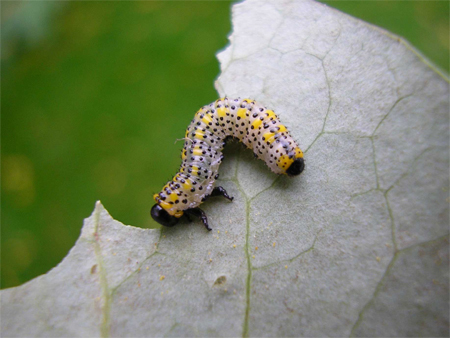It’s official! An expert on such matters (from the Royal Horticultural Society in Wisley) confirmed late yesterday that the creatures who, as I write, are devouring the berberis bush in our garden on the outskirts of York (in the north of England), have never ever been recorded in Yorkshire before!
A world first happening in our garden right now!
Berberis sawfly (Arge berberidis) larvae.
What do Berberis sawfly larvae look like? How did I spot them? How did I work out what they were? Where have they come from? And what’s the poem I’ve written about them? All will be revealed, dear reader … here
First things first. This is a Berberis sawfly larva (eating one of our berberis leaves):
Find out more about Berberis sawflies (including photos of eggs, larvae and adults) here
Anneliese Emmans Dean info@theBigBuzz.biz


Hi, I too have these on my berberis bush. I had them last summer too but sprayed the bush and as it developed this year thought they had been eradicated !!! But no, they are back again right now! How did you get rid of yours? I really would prefer my plant to keep its leaves this year!
Hi Christina
As my larvae appeared in the autumn (late October), and the berberis is deciduous anyway, I just let them get on with it and enjoyed watching them. I might have been less sanguine if they’d appeared in the spring …
Where are you in the country? There are scientists monitoring the spread of Berberis sawfly larvae in Britain who would be interested in hearing about your sighting. I’d advise contacting Andrew Halstead at the Royal Horticultural Society in Wisley (andrewhalstead@rhs.org.uk). He is also an expert on pest eradication, so he may be able to advise you on what to do if you really don’t enjoy watching the larvae nibble away quite as much as I did!
Hope that helps.
Best wishes
Anneliese
I noticed today (26 August 2007) that my berberis hedge was looking somewhat “leafless”. On closer inspection I discovered that the whole hedge (about 20 feet long by 5 feet high) was under attack from sawfly larvae and the caterpillars were everywhere. As yet, I don’t know what will eradicate them with regard to sprays etc, so my husband and I gave the hedge a rather early drastic pruning. No doubt there are still some larvae that have survived the pruning and I will email Andrew Halstead at RHS to find out what he suggests.
I live in Abingdon, South Oxfordshire – I too had my varied collection of Berberis sp attacked by these caterpillars last week. I note that they went for the larger [red] leaf specimens rather than the smaller pink and/or green leaves. Additionally they went for the fully grown leaf first – those at the base of the stalk rather than the younger smaller leaves at the tops of the stalks.
I got so annoyed that I took a can [or two] of Raid anti-wasp spray and blasted the plants – to good effect! Possibly not very green but it works!
I have (or had) a berberis hedge in my garden in Chamonix, France (altitude 1150m). This has been completely defoliated this year by what looks like the berberis sawfly. This is despite a winter under snow and temperatures down to minus 15 deg C.
Help please.